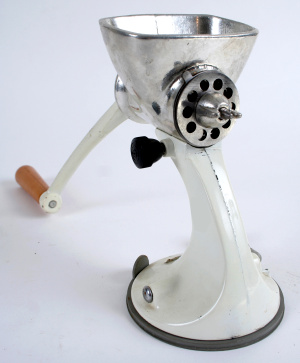 One of my ten goals for 2010 was to learn how to make sausages. I’ll admit it was a bit of an easy one — the “make to-do” list item on your to-do list just so you can cross something off straight away — as I was already planning on attending a sausage making course in March. When March came along though, I was incredibly disappointed when we had to cancel our places a couple of days before the course – and delighted when Rachel, the course organiser, said they were running the course again a month later, and would we like to attend that instead?
One of my ten goals for 2010 was to learn how to make sausages. I’ll admit it was a bit of an easy one — the “make to-do” list item on your to-do list just so you can cross something off straight away — as I was already planning on attending a sausage making course in March. When March came along though, I was incredibly disappointed when we had to cancel our places a couple of days before the course – and delighted when Rachel, the course organiser, said they were running the course again a month later, and would we like to attend that instead?
The course took place on Saturday at Old Sleningford Farm – a lovely informal community/small holding near Ripon in North Yorkshire. The drive up showed off Yorkshire at its best – the sun shining on all the hills, dales and cute cottage-filled villages – and when we got there, the group were having a cup of tea in the sunshine next to the herb garden. There were five of us on the course, plus Rachel & Martin, who ran the session together.
Once the tea was supped, we headed into the purpose-built kitchen and Rachel & Martin told us about their experiences developing the recipes, how they’d come up with their fatty/lean meat ratio and why they used homemade bread instead of rusk. Then we read through the recipes of the sausages we’d be making – all standard wet pork sausages but we were given two recipes for dried/smoked sausages and throughout the day, they discussed how each stage would be different if we were making them (we also got to try the dried sausages at lunchtime – super yum!). They had also thoughtfully copied out large versions of the recipes and hung them on the walls so we didn’t keep having to refer to our take-home A4 papers.
For the rest of the morning, we made the sausage meat. In total, between the seven of us, we made 25kg of sausage meat in five flavours: plain, herby, sage & onion, cumberland and garlic & rosemary. We used both manual and electric mincers to see the different textures produced by different settings, and it was interesting to see how things blended more with repeated mincings.
Once all the meat was minced, we left Martin cooking up some tasting patties for lunch while Rachel showed us around the farm. We met their three pigs – the mum and the sisters of the pigs currently sizzling away in the kitchen – and we tickled the younger ones’ bellies as they sunbathed. I got muddy pig snot all up my jeans. Rachel told us about their experiences so far – they’ve been there for just under six years – and their plans for the future, which was really fascinating and inspiring :)
Lunch was splendid – back in the herb garden, we had homemade bread and homegrown/foraged salad as well as a sample of each of the sausage meat patties and slices of their salami and smoked garlic sausage. For those who are not as anti-fruit/alcohol as me, there was homegrown/pressed apple juice and cider. Our lunch food miles were measured in metres and it was all delicious. For dessert, Martin whipped up a plum upside-down cake which was also fantastic. We didn’t want to go back to work after that feast but the sausages wouldn’t skin themselves.
The hog casings on spools looked and felt very strange but once we got into the rhythm of it, it was easier than we thought it would be – rather satisfying too, making sure the casings weren’t too full or too empty, and keeping the metres of emerging sausage tidy! John & I stuffed the cumberland and plain ones, then we linked those up too – the linking really drove home the importance of stuffing them at the correct density.
We both very much enjoyed the course – and have very much enjoyed eating the sausages we brought home at the end of it! We’re plan to get a mincer/stuffer at home to make our own batches in the future and I’d definitely like to try dried/smoked ones too, especially now I’ve identified that our little garage will be a near perfect place to leave them hanging.
I’d thoroughly recommended the course for anyone wanting to give sausage-making a go – and will more than likely be returning for more course at Old Sleningford in the future.
(Photo by peteralbre)

Leave a Reply